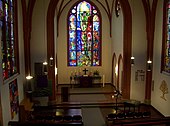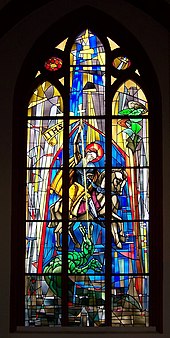St. Georg (Bremen)
The Church of St. Georg in the Bremen district of Huchting belongs to the Protestant St. Georgs community. It was built in the place of a medieval church from 1877–1879. The building has been a listed building since 1994.
history
There is documentary evidence of a single-nave, small village church made of field stones in Huchting in 1266 with a small square west tower. Presumably it was decades older and for centuries the ecclesiastical center of the villages of Kirch-, Mittel- and Brokhuchting. Comparable medieval brick buildings are still preserved in the neighboring communities of Stuhr and Arsten . The old Huchtingen church is shown on an information board next to the church and in a drawing by Homann from 1825 and in a photo from around 1875.
From 1877 to 1879 today's church was built according to plans by the architects Eduard Gildemeister and Heinrich Deetjen , a neo-Gothic brick building with a slim, 46-meter-high tower. The interior of the nave is 18.25 m long, 9 m wide and 11.30 m high and offers space for 300–400 people, depending on the seating. The construction costs amounted to 45,000 marks , of which the Huchtinger raised 30,000 marks themselves. For the municipality, which at that time was counted as “one of the lowest in the state of Bremen”, this was a considerable financial achievement.
During the Second World War, the church was damaged over 60% by shelling in April 1945, as it served as an artillery observation post. In the post-war period, the building was repaired, the peal was extended to three bells and the interior was renovated in 1963. Own funds for this could be obtained from the sale of a property to Thyssenkrupp Schulte GmbH. The architect Carsten Schröck was in charge . Another renovation followed in 1991/1992 under the direction of architect Timm, in particular the neo-Gothic character of the church was restored: the cross vault was highlighted in color by painting the clinker strips in red.
Furnishing
Altar table and pulpit
When the interior was redesigned in 1963, Carsten Schröck designed the pulpit front and altar table as simple, large-area slabs of green marble . The Lord's Supper is on the east side of the nave, under the glass window with the image of the crucified. The altar decoration consists of a bronze cross and four brass chandeliers with the symbols of the evangelists (human, bull, lion, eagle) and - as in front of the pulpit - an antependium .
Baptismal font
The brass bowl in the marble baptismal font from 1958 bears the inscription: "One body - one master - one faith - one baptism".
Stained glass window
The seven glass windows, made according to designs by Will Torger at the K. Lendenroth Glassworks 1965–1967, give the bright church interior a strong charisma with their luminosity: the altar window with the crucified, the baptismal window above the baptismal font with the baptism of Jesus in the Jordan by Johannes "The Baptist" . The pulpit window opposite shows Jesus preaching, Jesus praying, conscious of his approaching death, is shown in the Gethsemean window. The St. George - namesake of the church since the beginning of the 13th century - shows the St. George fighting the dragon. In the organ gallery is the David window with Saul , the first king of Israel, and David - later the greatest king of Israel - as a harpist. On the other side of the gallery the angel window with angels playing music and "the Lamb of God who bears the sin of the world" at the top of the window.
organ
The organ above the glass entrance door from the Alfred Führer organ building workshop dates back to 1958. It followed the smaller and simpler instrument taken over from the Reformed community of Blumenthal after 1879, and for decades contributed to a focus on church music in community work. As part of Schröck's interior design in 1963, the organ was painted blue. It was re-voiced in 1977. A thorough renovation and tonal revision took place in 1994. About 1550 pipes sounded in 24 registers via two manuals and pedal .
|
|
|
||||||||||||||||||||||||||||||||||||||||||||||||||
Organists
- –1962: Marie Auel
- 1962–1997: Nikolaus Dorsch
- 1997–2007: Ruth Drefahl
- 2008– : Manuela Buchholz
Bells and tower clock
The three bells from 1956 were supplied by the renowned Otto bell foundry in Hemelingen. They have the following diameters: 1081 mm, 963 mm, 809 mm and the strike note series: f sharp - g sharp - b. The bell inscription is distributed on all bells and quotes the apostle Paul ( Rom 12,12 LUT ): "Be happy in hope" - "Be patient in tribulation" - "Stop in prayer". They sound every quarter of an hour during the day at the strike of the clock and within the framework of the chime . The tower clock from 1958 opens on the north, west and south sides and is thus visible from the entire parish . This fact is mentioned for the following reason: A protracted dispute about the financing of the first church clock on the tower of the then village church of Huchtings is rumored from around 1800. The first clock had only one dial, which pointed south to the Kirchhuchting district. The residents of Mittelhuchting to the west therefore initially refused to pay the share of the financing that was incumbent on them in accordance with the pay-as-you-go system ("Baufuß") that was in force at the time, as they could not see the tower clock.
local community
The St. George's community has a pastor's office and eight full-time and part-time employees. In addition, there are around 20 employees at the daycare center that has existed since 1965 . There, 95 disabled and non-disabled children are cared for and supported in five groups. The community has been running the St.-Georgs-Hof youth center in Düngstrup near Wildeshausen since 1969 . The Georgshof was and is being built and maintained by a continuous group of volunteers; administration is the responsibility of a part-time employee.
The St. Georgs Congregation currently has almost 3,700 members (as of January 1, 2008). Until the 1950s, the municipality included the entire district of Huchting. The church membership development followed the population development up to a high of tens of thousands of church members in the late 1950s. As a result, four independent neighboring communities were spun off. In response to the noticeable decline in membership numbers, which has been seen as a challenge across the church since the turn of the millennium, the St. Georgs Congregation has now been part of a comprehensive group again since 2006 with two of these congregations, the St. Lukas Congregation and the Dietrich Bonhoeffer Congregation , Priorities and work areas re-weighting the cooperation process . The conceptual and canonical basis of the cooperation is the cooperation agreement of June 29, 2008. In the area of church music, St. Georg has been cooperating with the Christ Church in Woltmershausen since January 1, 2008 . Nicole Steinbächer has been pastor of the Evangelical St. Georgs Congregation in Bremen-Huchting since 2008.
Constitutional history
The St. George community has been under the patronage of Bremen Cathedral since ancient times . Since the Reformation it was then assigned to the church regiment of the Bremen Council under the name of "Huchting Church Community" . The position as a so-called “rural community” brought with it a special, highly complex tax and contribution system which - in contrast to the freedom of choice for every believer in the urban area - required a strictly territorial parish compulsion . As a result, however, a large amount of own funds were generated in the rural communities. This may have persuaded the council in September 1850 to powerfully defend this "medieval" model of a large number of small and very small tax and remuneration items against all considerations of extending new, more liberal municipal constitutions of the rural communities to include questions of community financing. It was only with the establishment of the Bremen Evangelical Church (BEK) in 1920 that the rural parishes were given the same constitutional status as the city parishes.
Confessional history
A denominational definition as a decidedly Reformed congregation in contrast to Lutheranism was still recognizable in the election of Pastor Wessels (term of office 1915–1947). The congregation's freedom of confession, which is associated with membership of the BEK , made it possible for Pastor Baeßler (term of office 1947–1974) in Huchting to be appointed to the preaching office since the Reformation and to use the pre-Reformation name “St. Georgs-Gemeinde ”was reintroduced. With the altar table from 1963, the Reformed tradition and the Lutheran creed find equal shape: It is a table of Reformed design with Lutheran furnishings (see above). From the time of the church struggle (1933ff.) A predominantly uncritical national-conservative position of the pastor and the congregation at the time has been handed down, a line of members of the Stahlhelm in front of the church portal on the occasion of a wedding is documented in photographs.
Between 1969 and 2004 there was a second pastorate. Its incumbent, Pastor Schmidt, brought a moderate evangelical character to the congregation. The modernizing awakening in the forms of piety and worship, which was initially welcomed in many ways, was also accompanied by a sometimes tough conflict of direction, which threatened to divide the full-time and voluntary workforce. This concerned in particular the term of office of the following Baeßler, orthodox Lutheran, theologically liberal colleague, Pastor Dietrich Altmann (term of office 1974-1993, son of Hans Altmann ). His successor, Pastor Renate Thiele (1993–2006), succeeded in adopting a pastoral and integrative approach, through which the aforementioned “trenches” for practical congregational work lost their importance compared to a stronger feeling of belonging.
graveyard
The small, Protestant cemetery of the parish from the 13th century is right next to the church.
See also
- Bremen church history
- Bremen Evangelical Church
- List of organ registers
- List of cultural monuments in Huchting
literature
- A. Mönnich, W. Lindow (Ed.): 1879–1979. 100 years of St. George's Church. Bremen 1979.
- Hans Baeßler: The windows in the St. George's Church in Bremen-Huchting. Church council, Bremen 1984.
- Claus Heitmann: From Abraham to Zion. The Bremen Evangelical Church. Temmen, Bremen 2000, ISBN 3-86108-619-0 .
- Claus Heuer: Pastors of the Ev. Kirchhuchting parish. In: 125 years of St. George's Church. St. George's Letter No. 26, July 2004.
- Emil Höfner: History of the St. George's Church. Lecture on the 125th anniversary on August 22, 2004.
- Nikolaus Dorsch: Booklet to the CD Works by Johann Sebastian Bach - Nikolaus Dorsch on the organ of St. Georgs Church, Bremen-Huchting ; Self-published without date
- Nikolaus Dorsch: Our St. Georgs organ is 50 years old. In: Together . Community letter for the Ev. Municipalities Dietrich-Bonhoeffer, St. Georg, St. Lukas, No. 4, September – November 2008.
- Gerhard Reinhold: Otto Glocken - Family and company history of the bell foundry dynasty Otto. Essen 2019. ISBN 978-3-00-063109-2 .
- Gerhard Reinhold: Church bells - Christian world cultural heritage, illustrated using the example of the bell founder Otto, Hemelingen / Bremen. Diss. Radboud Universiteit Nijmegen, 2919. DNB access signature L-2019-333968.
Individual evidence
- ^ Monument database of the LfD
- ^ Gerhard Reinhold: Otto bells. Family and company history of the bell founder Otto . Self-published, Essen 2019, ISBN 978-3-00-063109-2 , p. 588 (here in particular. P. 584).
- ↑ Gerhard Reinhold: Church bells - Christian world cultural heritage, illustrated using the example of the bell founder Otto, Hemelingen / Bremen . Nijmegen / NL 2019, p. 556, here in particular p. 505 , urn : nbn: nl: ui: 22-2066 / 204770 (PhD thesis at Radboud University Nijmegen).
- ↑ Ring on YouTube
Web links
- St. George's community in the BEK
- St. Georg day care center
Coordinates: 53 ° 3 ′ 4.7 " N , 8 ° 44 ′ 28.9" E


